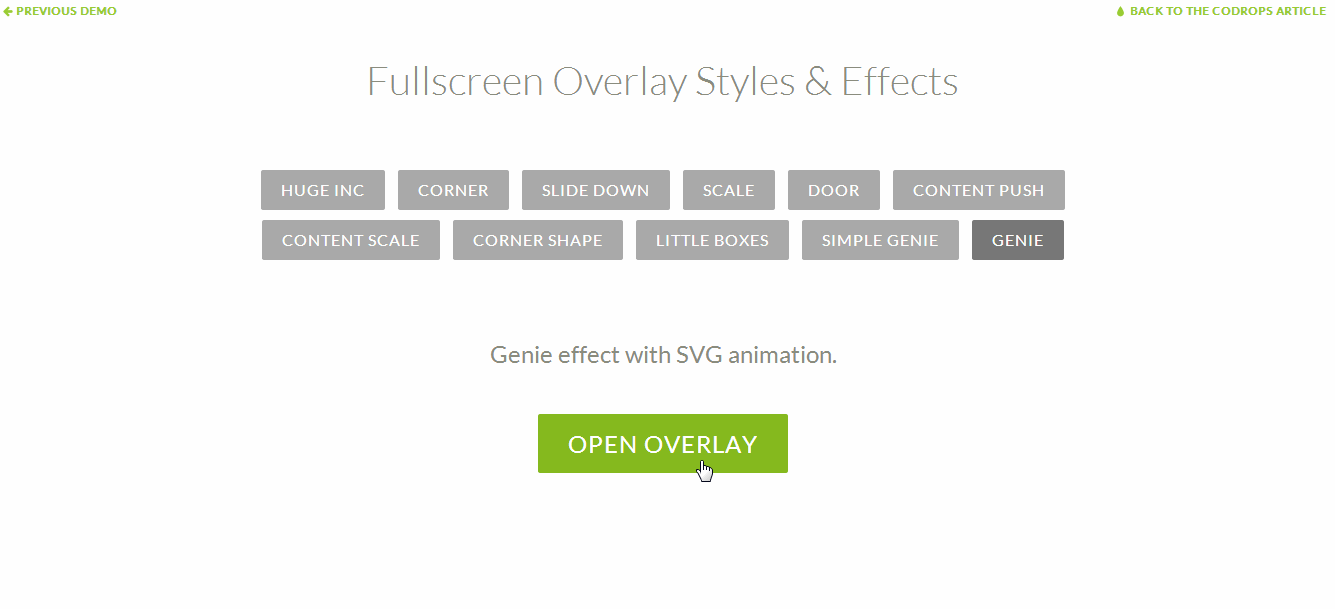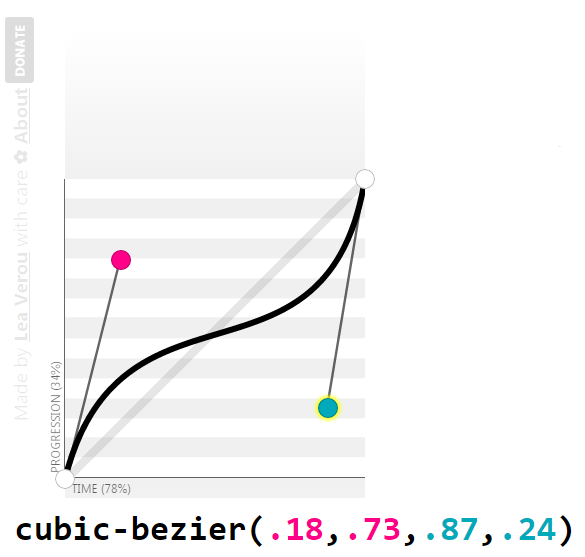Animating SVG with CSS and SMIL
Fronteers, Amsterdam, October 10th, 2014
Hello!


Animating SVGs
-
Using CSS
-
Using SVG Animations (SMIL)
-
Using Javascript*
*We won't be covering JS in this talk
CSS'ing SVGs
<svg xmlns="http://www.w3.org/2000/svg" version="1.1" width="300px" height="300px" viewBox="0 0 300 300">
<polygon
fill = "#FF931E"
stroke = "#ED1C24"
stroke-width = "5"
points = "279.1,160.8 195.2,193.3 174.4,280.8 117.6,211.1 27.9,218.3 76.7,142.7 42.1,59.6 129.1,82.7 197.4,24.1 202.3,114 "/>
</svg>
Before CSS: SVG Presentation Attributes
star.svg
Shared with CSS |
SVG-Only |
|---|---|
|
|
clip-rule, flood-color, flood-opacity, stop-opacity, kerning, tech-anchor, color-profile, color-rendering, fill, fill-opacity, fill-rule, marker, marker-end, marker-mid, marker-start, stroke, stroke-width, stop-color, lighting-color, enable-background, dominant-baseline, color-interpolation-filters, color-interpolation, glyph-orientation-horizontal, glyph-orientation-vertical, shape-rendering, baseline-shift, alignment-baseline, stroke-miterlimit, stroke-linejoin, stroke-linecap, stroke-dashoffset, stroke-dasharray, stroke-opacity |
In SVG2, more presentation attributes will be added.
<svg xmlns="http://www.w3.org/2000/svg" version="1.1" style="width: 300px; height: 300px;" viewBox="0 0 300 300">
<polygon
style="fill: #FF931E; stroke: #ED1C24; stroke-width: 5;"
points = "279.1,160.8 195.2,193.3 174.4,280.8 117.6,211.1 27.9,218.3 76.7,142.7 42.1,59.6 129.1,82.7 197.4,24.1 202.3,114 "/>
</svg>
Inline Styles (style="...")
star.svg
<svg xmlns="http://www.w3.org/2000/svg" version="1.1" width="300px" height="300px" viewBox="0 0 300 300">
<style type="text/css">
polygon { fill: ... ;}
</style>
<polygon points = "279.1,160.8 195.2,193.3 174.4,280.8 117.6,211.1 27.9,218.3 76.7,142.7 42.1,59.6 129.1,82.7 197.4,24.1 202.3,114 "/>
</svg>
Embedded Styles (<style>) Inside SVG
star.svg
<!DOCTYPE html> <html><head>...</head>
<body>
<style type="text/css">
svg { width: ...; }
polygon { fill: ... ; }
</style>
<svg version="1.1" viewBox="0 0 300 300">
<!--SVG content-->
</svg>
</body>
</html>
Embedded Styles (<style>) Outside SVG
star.svg
External Style Sheets
<?xml version="1.0" standalone="no"?>
<?xml-stylesheet type="text/css" href="styles.css"?>
<svg xmlns="http://www.w3.org/2000/svg" version="1.1" width="300px" height="300px" viewBox="0 0 300 300">
<!-- SVG Content -->
</svg>
star.svg
Animating SVGs with CSS
Using CSS Transitions
Example: Iconic



Using CSS Animations & Transforms
transform-origin: SVG vs HTML
transform-origin (default value)
HTML Elements (div, ::before, etc.)
SVG Elements (circle, rect, etc.)
50% 50%
(the center of the element itself, calculated relative to its box model)
0 0
(top left corner of the SVG canvas, not of the element itself)

transform-origin: SVG vs HTML
Example: 45deg Rotation
<!DOCTYPE html>
<div style="width: 100px; height: 100px; background-color: orange"> </div>
<svg style="width: 150px; height: 150px; background-color: #eee">
<rect width="100" height="100" x="25" y="25" fill="orange" />
</svg>
Setting transform-origin in SVG using CSS
- Using percentage values: The value is set relative to the element's bounding box, which includes the stroke used to draw its border.
- Using absolute values: The origin is set relative to the SVG canvas.
Setting transform-origin in SVG using CSS
Example

<!DOCTYPE html><style>
div, rect { transform-origin: 50% 50%; }
</style>
Setting transform-origin in SVG using CSS
FIREFOX BUG
Setting transform-origin in percentages does not work as expected. Use absolute values instead.
Example Animations Demo
.wheel {
-webkit-transform-origin: 50% 50%;
transform-origin: 193px 164px;
animation: spin 4s cubic-bezier(.49,.05,.32,1.04) infinite alternate;
}
@keyframes spin {
50% {
transform: rotate(360deg);
}
}
3D Transforms
They work!
But...
Bugs!
- perspective doesn't currently work in Chrome
- 3D transforms on SVG elements are (currently) not hardware-accelerated in Chrome. They have the same performance profile as SVG transform attributes.
Animating SVG with CSS: Current Limitations
Example: Motion Along a Path
Motion Along a Path in CSS

Example: Morphing Shapes

And animating other attributes that simply cannot be set/styled/changed via CSS..
Animating SVG with SMIL
Synchronized Multimedia Integration Language
- Define an XML-based language that allows authors to write interactive multimedia presentations.
- Allow reusing of SMIL syntax and semantics in other XML-based languages, in particular those who need to represent timing and synchronization. For example, SMIL components are used for integrating timing into XHTML and into SVG.
What
Why
- Declarative (Info)
- Can animate attributes that CSS can't
- Animations work when SVG is embedded as <img> or as background image in CSS
- Event handling & animation synchronization capabilities
Current Browser Support
SMIL animations work in all browsers except IE and Opera Mini
Applying Animations:
SVG/SMIL Animation Elements
<animate>
Used to animate scalar attributes and properties over a period of time.
<animateTransform>
Used to animate one of SVG's transformation attributes over time, such as the transform attribute.
<animateMotion>
Used to animate/move an element along a motion path.
<set>
Used to assign animation values to non-numeric attributes and properties (e.g visibility).
Animation Attributes:
Naming Animations
<animate id="myAnim"
attributeName=" "
from=" "
to=" "
...
/>
id
*You don't need to specify an animation name for the animation to work.
Animation Attributes: Specifying the target of the animation
<animate xlink:href="#myElement"
id="myAnim"
attributeName=" "
from=" "
to=" "
...
/>
xlink:href
*The target element must be part of the current SVG document fragment.
Nesting the animation element inside the target
<circle cx="50" cy="50" r="20">
<animate
attributeName=" "
from=" "
to=" "
... />
</circle>
Animation Attributes:
Specifying the target attribute of the animation
<animate xlink:href="#myCircle"
id="myAnim"
attributeName="cx"
from=" "
to=" "
...
/>
attributeName
*Only one attribute name can be specified per animation element.
<animate xlink:href="#myCircle"
ID="myAnim"
attributeName="cx"
attributeType="XML"
from=" "
to=" "
...
/>
attributeType
*The attributeType can be either "XML", "CSS", or "auto".
Animation Attributes:
Simple animation from one value to another, over a duration of time
<animate id="move" link:href="#myCircle"
attributeName="cx" attributeType="XML"
from="50"
to="450"
dur="5s"
/>
CSS Equivalent
animation-name: move;
animation-duration: 5s;
@keyframes move {
from {/* ... */}
to { /* ... */ }
}
Animation Attributes:
Specifying the end state of the animation
<animate id="move" xlink:href="#myCircle"
attributeName="cx" attributeType="XML"
from="50" to="450"
dur="5s"
fill="freeze"
/>
CSS Equivalent
animation-name: move;
animation-duration: 5s;
animation-fill-mode: forwards;
@keyframes move {
from {/* ... */}
to { /* ... */ }
}
Animation Attributes:
Repeating Animations
<animate id="move" xlink:href="#myCircle"
attributeName="cx" attributeType="XML"
from="50" to="450"
dur="3s" fill="freeze"
repeatCount="indefinite"
repeatDur="00:30"
/>
CSS Equivalent
animation-name: move;
animation-duration: 5s;
animation-fill-mode: forwards;
animation-iteration-count: infinite;
@keyframes move {
from {/* ... */}
to { /* ... */ }
}
Animation Attributes:
Controlling animation begin time
<animate xlink:href="#myCircle"
attributeName="cx" attributeType="XML"
from="50" to="450"
dur="1s"
fill="freeze"
begin="click"
/>
CSS Equivalent
There is none.
Animation Attributes:
Synchronizing Animations
Examples of values
begin
click focus click + 2s click + 01:30 click + 01:05:33 1s 15min indefinite (relies on JS) otherAnim.begin otherAnim.begin + 1s otherAnim.end - 1min otherAnim.repeat(1) otherAnim.repeat(1) + 5s
<circle id="orange-circle" r="30" cx="50" cy="50" fill="orange" />
<rect id="blue-rectangle" width="50" height="50" x="25" y="200" fill="#0099cc"></rect>
<animate xlink:href="#orange-circle" attributeName="cx" from="50"
to="450" dur="5s" fill="freeze" begin="click" id="circ-anim"/>
<animate xlink:href="#orange-circle" attributeName="fill" from="orange"
to="#0099aa" dur="2s" fill="freeze" begin="circ-anim.begin + 5s"
id="circ-color-anim"/>
<animate xlink:href="#blue-rectangle" attributeName="x" from="50"
to="425" dur="5s" fill="freeze" begin="circ-anim.begin + 1s" id="rect-anim"/>
Example
Animation Attributes:
Restarting Animations
<animate id="move"
link:href="#myCircle"
attributeName="cx"
attributeType="XML"
from="50"
to="450"
dur="1s"
fill="freeze"
begin="click"
restart="whenNotActive"
/>
CSS Equivalent
There is none.
Animation Attributes:
Controlling animation keyframe values and pacing
The CSS Animations Way
@keyframes bounce {
0% {
top: 0;
animation-timing-function: ease-in;
}
15% {
top: 200px;
animation-timing-function: ease-out;
}
30% {
top: 70px;
animation-timing-function: ease-in;
}
/*...other keyframes...*/
90% {
top: 170px;
animation-timing-function: ease-in;
}
100% {
top: 200px;
animation-timing-function: ease-out;
}
}
<animate
id="bounce"
xlink:href="#orange-circle"
attributeName="cy"
from="50"
to="250"
dur="3s"
begin="click"
fill="freeze"
values="50; 250; 120;250; 170; 250; 210; 250"
keyTimes="0; 0.15; 0.3; 0.45; 0.6;
0.75; 0.9; 1"
keySplines=".42 0 1 1;
0 0 .59 1;
.42 0 1 1;
0 0 .59 1;
.42 0 1 1;
0 0 .59 1;
.42 0 1 1;
0 0 .59 1;"
calcMode="spline"
/>
The SMIL Animations Way
- calcMode = linear | discrete | paced | spline
- keyTimes are fractions, not percentages
- nb. of keyTimes == nb. of values == nb. of keySplines + 1
- keySplines use control points coordinates, not the bezier function syntax
Notes
keySplines control points: visual representation

Animation Attributes:
Additive and Accumulative Animations
- Useful for repeating animations
- Animation starts relative to current value.
- Animation proceeds building up on the result of the previous iteration.
additive & accumulate
<animate
xlink:href="#orange-circle"
attributeName="cx"
from="0"
to="100"
additive="sum"
accumulate="sum"
repeatCount="3"
calcMode="spline"
keyTimes="0;1"
keySplines=".42 0 1 1"
dur="1s"
begin="click"
fill="freeze"
/>
<circle id="orange-circle" r="30" cx="50" cy="50" fill="orange" />
additive & accumulate
additive
accumulate
Animation Attributes:
Explicitly specifying an animation's end time
<animate
xlink:href="#orange-circle"
attributeName="cx"
from="50"
to="450"
dur="1s"
begin="click"
fill="freeze"
id="move"
/>
<animate xlink:href="#orange-circle" attributeName="fill" from="#0099CC" to="deepPink" dur="5s" repeatCount="indefinite" begin="0s" end="move.begin" fill="freeze" />
Animation Attributes:
Specifying animation intervals
<animateTransform
xlink:href="#deepPink-rectangle"
attributeName="transform"
attributeType="XML"
type="rotate"
from="0 75 75"
to="360 75 75"
dur="2s"
fill="freeze"
begin="click; 5s; 9s; 17s;"
end="2s; 8s; 15s; 25s;"
/>
Animation Attributes:
Restricting the entire active duration of an animation with `min` and `max`
<animate> animation example
Shape Tweening
<path fill="#1EB287"> <animate attributeName="d" dur="1440ms" repeatCount="indefinite" keyTimes="0; .0625; .208333333; .3125; .395833333; .645833333; .833333333; 1;" calcMode="spline" keySplines="0,0,1,1; .42,0,.58,1; .42,0,1,1; 0,0,.58,1; .42,0,.58,1; .42,0,.58,1; .42,0,.58,1" values="M 0,0 C 50,0 50,0 100,0 100,50 100,50 100,100 50,100 50,100 0,100 0,50 0,50 0,0 Z; M 0,0 C 50,0 50,0 100,0 100,50 100,50 100,100 50,100 50,100 0,100 0,50 0,50 0,0 Z; M 50,0 C 75,25 75,25 100,50 75,75 75,75 50,100 25,75 25,75 0,50 25,25 25,25 50,0 Z; ... " /> </path>
<animateTransform> animation example
<animateTransform
xlink:href="#deepPink-rectangle"
attributeName="transform"
attributeType="XML"
type="rotate"
from="0 75 75"
to="360 75 75"
dur="2s"
begin="0s"
repeatCount="indefinite"
fill="freeze"
/>
All about SVG transforms:
http://sarasoueidan.com/blog/svg-transformations/
<set> animation example
<set
xlink:href="#deepPink-rectangle"
attributeName="fill"
to="#0099AA"
begin="click"
dur="3s"
/>
Animations along arbitrary paths:
<animateMotion>
Specifying a motion path
<animateMotion
xlink:href="#circle"
dur="1s"
begin="click"
fill="freeze"
path="M0,0c3.2-3.4,18.4-0.6,23.4-0.6c5.7,0.1,10.8,0.9,16.3,2.3 c13.5,3.5,26.1,9.6,38.5,16.2c12.3,6.5,21.3,16.8,31.9,25.4c10.8,8.7,21,18.3,31.7,26.9c9.3,7.4,20.9,11.5,31.4,16.7
c13.7,6.8,26.8,9.7,41.8,9c21.4-1,40.8-3.7,61.3-10.4c10.9-3.5,18.9-11.3,28.5-17.8c5.4-3.7,10.4-6.7,14.8-11.5
c1.9-2.1,3.7-5.5,6.5-6.5"
/>
OR
<animateMotion xlink:href="#circle" dur="1s" begin="click" fill="freeze">
<mpath xlink:href="#motionPath" />
</animateMotion>
1
2
<path id="motionPath" d="..." />
1
2
Setting the orientation
without changing orientation
<animateMotion
xlink:href="#car"
dur="3s"
begin="0s"
fill="freeze"
repeatCount="indefinite"
rotate="auto">
<mpath xlink:href="#motionPath" />
</animateMotion>
<animateMotion
xlink:href="#car"
dur="3s"
begin="0s"
fill="freeze"
repeatCount="indefinite"
rotate="auto-reverse">
<mpath xlink:href="#motionPath" />
</animateMotion>
Setting the orientation
flipping the car with transforms
Controlling the animation distance along the motion path
Animationing <text> along arbitrary paths
Laying text along a path
<path id="myPath" fill="none" stroke="#000000" stroke-miterlimit="10" d="M91.4,104.2c3.2-3.4,18.4-0.6,23.4-0.6c5.7,0.1,10.8,0.9,16.3,..."/> <text> <textpath xlink:href="#myPath"> Text laid out along a path. </textpath> </text>
Animating the text offset
<text>
<textpath xlink:href="#myPath">
Text laid out along a path.
<animate attributeName="startOffset" from="0%" to ="100%" begin="0s" dur="5s" repeatCount="indefinite" keyTimes="0;1" calcMode="spline" keySplines="0.1 0.2 .22 1"/>
</textpath>
</text>
Animatable elements & attributes:
Embedding SVGs
Embedding Technique
CSS Animations
<img src="mySVG.svg" alt=".." />
CSS Interactions
Yes, only if inside <svg>
No
.el {background: url(mySVG.svg);}
No
Yes, only if inside <svg>
<object type="image/svg+xml" data="mySVG.svg"><!--fallback--></object>
Yes, only if inside <svg>
Yes, only if inside <svg>
<embed type="image/svg+xml" src="mySVG.svg" />
Yes, only if inside <svg>
Yes, only if inside <svg>
<iframe src="mySVG.svg"><!--fallback--></iframe>
Yes, only if inside <svg>
Yes, only if inside <svg>
<svg><!--SVG content--></svg>
Yes
Yes
Embedding Technique
SMIL Animations
<img src="mySVG.svg" alt=".." />
SMIL Interactions
Yes
No
.el {background: url(mySVG.svg);}
No
Yes
<object type="image/svg+xml" data="mySVG.svg"><!--fallback--></object>
Yes
Yes
<embed type="image/svg+xml" src="mySVG.svg" />
Yes
Yes
<iframe src="mySVG.svg"><!--fallback--></iframe>
Yes
Yes
<svg><!--SVG content--></svg>
Yes
Yes
